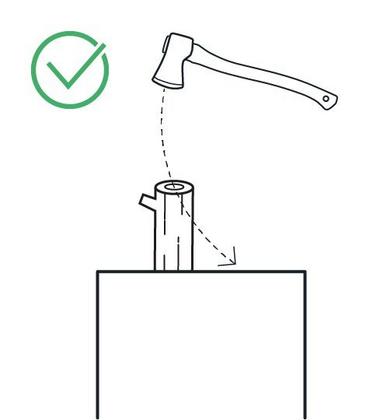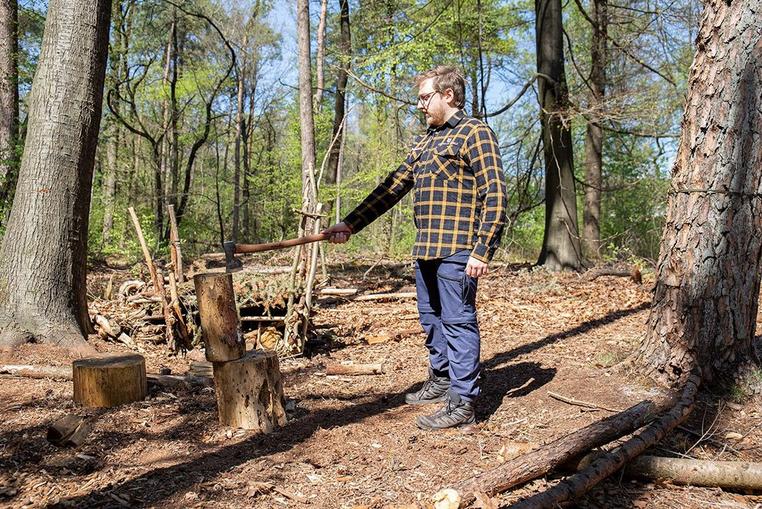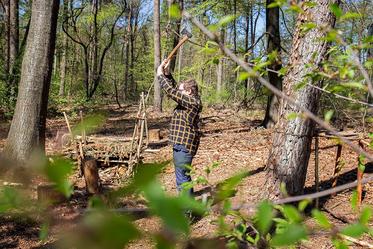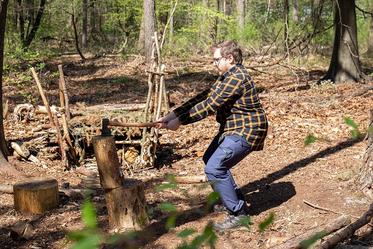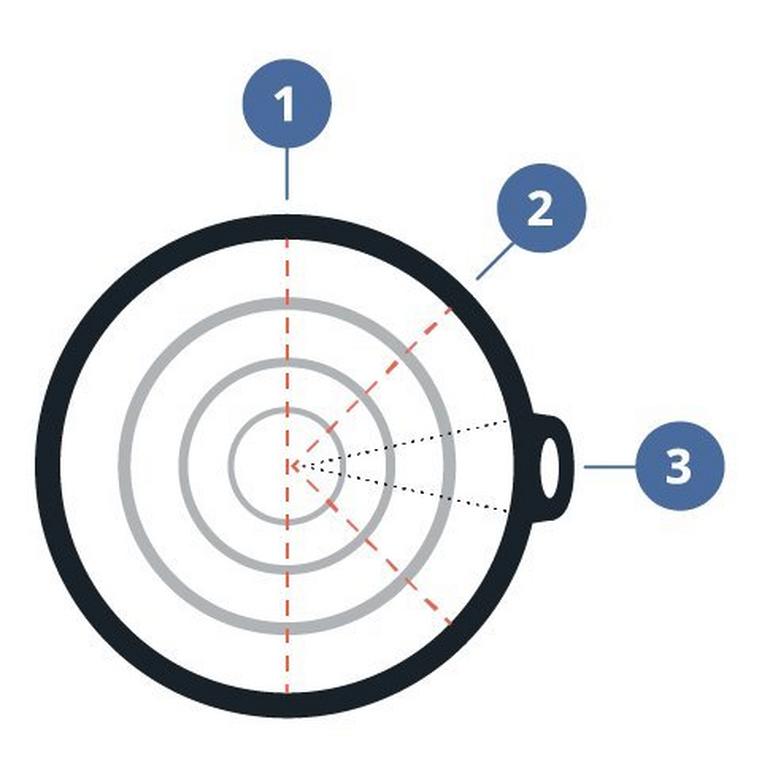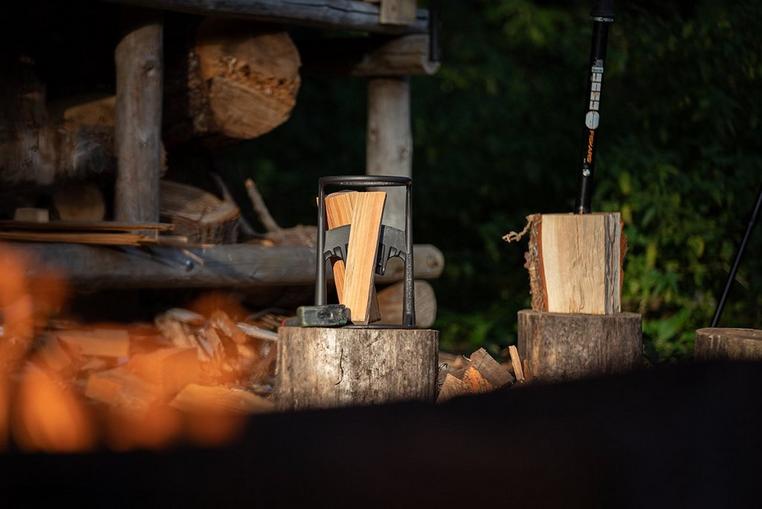How to: split wood
The splitting of wood is turning the trunk of the tree into smaller pieces of (fire)wood. These pieces of wood are suited for the drying stack and later for in the fireplace or campfire. You usually split freshly cut or sawn wood. Fresh wood is easier to split, so don't wait too long after cutting down a tree! In this topic we will tell you all about how you split your own firewood. Want to lean more about kindling? We have another topic that focuses on splitting kindling specifically.
Contents
- Type of axe
- The chopping block
- Technique
- Break
- Overstrike guard
- Other ways to split wood
- How big does the wood need to be?
- Drying your wood
Type of axe
When splitting larger pieces of wood you use a splitting hammer or splitting axe. These axes are a lot heavier and push the block apart. These axes are not razor-sharp. You use a splitting hammer if you also use a metal wedge as you split wood. You recognize a splitting hammer from its thicker casing and hammer-like back. As such this axe can handle quite a lot. Any other axe is not meant to be used when hitting metal. Because of the hard blows the axe could be damaged. As such you should never use another axe as a wedge.
Before you start your work always check to see if the head is properly attached to the handle. Also check the sharpness of the axe by slightly tapping the wood. Does the axe get stuck? If so the axe is sharp enough.
The chopping block
A good chopping block is a fundamental part when safely splitting wood. It ensures that the splitting axe won't swing back towards your legs and it also makes sure that the axe does not hit the ground.
The perfect chopping block is a straight piece of wood at knee height. Unable to find the right piece of wood? Rather use no chopping block at all than a block that is too high. When splitting wood without a chopping block the axe will hit the ground a lot more often causing the edge to become blunt faster as well, but at least the axe won't end up in your body.
The broader the block the better. Place the block on a solid base and always put the wood you want to split at the far edge of the chopping block. If you miss the piece of wood the axe will end up in the block and not in your leg.
Technique
In addition to the right chopping block, the right technique is key for efficiency, your own safety and the safety of others.
Determining the distance
Grab the axe with one hand at the end of the handle and stretch out your arm. Place the edge of the axe on the front edge of the piece of wood you wish to split. This is the right distance. When you split wood you, on average, hit about 10 cm further than you think. That is why you should always aim towards the front edge of the piece of wood you wish to split.
Safe working environment
Make sure you are working in a safe environment. For instance, never split wood around children. This is simply asking for things to go wrong. So what if someone wants to watch you split wood? Make sure they keep a safe distance and stand on either your left or right side. If they stand in front of you they are in big trouble when the head of the axe lets go or if the axe slips from your hand.
Splitting the wood
Pull the axe towards your chest (the edge facing forward) with one hand underneath the head and one hand at the knob of the handle. Push the axe up and grab the handle with both hands at the knob. Make sure that the axe is not leaning back. This is not good for your back. The axe is placed right over your head, now look in between your arms. As you drop the axe you bend your knees. If you do so properly the axe won't swing towards you but will end up in the chopping block or the ground. If successfully carried out the entire edge of the axe will hit the wood, splitting it open.
Hit multiple times
It is normal that you need to hit the piece of wood a couple of times, especially if you are splitting a large piece of wood. During this activity, unfortunately, also most axe handles bite the dust. It is the result of one problem that can easily be solved. Always place the piece of wood on the outer edge of the chopping block and aim for the front edge of the wood. If you aim for the back chances are the head will hit the back of the wood. The result is that the handle breaks off at the head. Another option is that the back part of the wood breaks, but the core doesn't. In this case the handle will also hit the wood which could cause it to break. So always hit the front edge of the wood. If need be you can always turn the wood to reach the place you want to hit.
An axe that gets caught in the wood
If your axe gets caught in the piece of wood you wish to split you should never lift the axe and the piece of wood. This could really damage your back and it is dangerous if the block suddenly let's go. Place your hand on the block you want to split to make sure it cannot move and hit the palm of your hand on the far end of the handle. As you do this you immediately take hold of the handle. Afterwards you slowly wedge the axe from the wood. Because of the shape of the head it will come out easily.
A knot
Unfortunately pieces of wood often contain knots. A knot is a part of the trunk from which a branch was starting to grow. The result is that splitting wood is a lot more difficult. Cutting through a large knot is nearly impossible. Even if you use a wedge and a splitting hammer. It is possible, but you will quickly need a long break. Not ideal if you need to split a lot of wood. That is why we always chop around the knot and leave the part that contains a knot alone. These parts containing knots are perfect for your campfire.
The knot grows all the way up to the core, but not further. That is why the first chopping line is perpendicular to the knot. As soon as you have split the part without knot, you split a little closer to the knot. Leave the last part as is.
Break
If, as you are splitting wood, you need a break hit the entire edge of the axe in the chopping block or piece of wood you wish to split. As such the edge cannot hurt anyone. Do, however, make sure the axe is not stored in the wood too long. Fresh wood is wet and can contain acids (tannic acids in case of an oak). This could leave you with a rusty axe.
Overstrike guard
Opinions differ on how effective an overstrike guard is. An overstrike guard is a piece of leather on the handle, located just below the head of the axe. It is meant to decrease damages if you miss. In a way the overstrike guard does what it is meant to do. However, if you miss, an overstrike guard won't do you much good. You could say that an overstrike guard gives you a fake sense of safety. Also because you cannot tell if the handle is damaged underneath the overstrike guard. So, yes, for light damages it could help but do regularly check the wood underneath the overstrike guard. We do have to admit though that an overstrike guard does look really cool.
Other ways to split wood
It is, of course, a good work-out to split your own firewood with a splitting axe, but if you are not sure what you are doing, it can also be dangerous. That is why there are also other ways to split wood. The Kindling Cracker, for instance. With it you split wood by putting a block inside and hitting it with a hammer. It is a simple way of splitting wood. The only disadvantage is that the block needs to be smaller than the top ring of the Kindling Cracker. You will find all alternative ways for splitting wood at our wood splitters.
How big does the wood need to be?
If you are busy splitting wood, you could continue until you only have small pieces of wood left. But which sizes are perfect for your firewood? The perfect size depends on the size of your fireplace. But for the average fireplace a diameter of 10-15 cm is ideal. A block such as that won't immediately burn up. It is also practical to have some smaller kindling; with it you make sure your fire will burn hard enough to get the larger blocks lit properly.
Drying your wood
If you split your own wood, you also need to dry it. Fresh wood contains 80% moisture and needs to dry first. Wet wood won't burn easily and also produces a lot of smoke. Also make sure your blocks are not too big, because thick blocks take longer to dry.
Where do you leave wood to dry?
Blocks that lie in the wind, dry best. As such it is best if you allow wood to dry underneath a shelter. It namely means that the wind can reach it, but also that the wood is protected from the rain. Don't cover the wood in plastic, otherwise it will not dry properly.
When is your wood dry?
With a moisture content of 20% your wood is dry enough to burn properly. Depending on the type of wood this can take up to 1.5 to 2 years. Types of wood that contain a lot of resin, such as pine, larch or spruce, are not as suited for burning in your stove or campfire. The resin namely produces a lot of sparks. Ash, lime tree, willow and birch need approx. 1.5 years to dry. Wood from fruit trees, oak and beech take a little longer. This wood takes approx. 2.5 years to dry.
| Type of wood | Drying time |
|---|---|
| Pine, Poplar | 1 year |
| Birch, Alder, Ash, Lime tree, Spruce, Willow | 1.5 years |
| Beech, Fruit tree | 2 years |
| Oak | 2.5 years |


